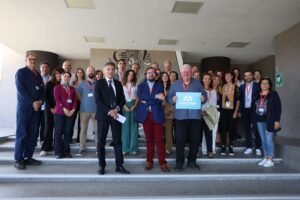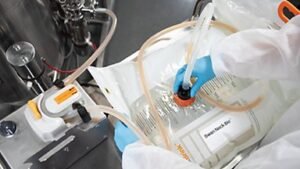Friday, 26 September 2025
Towards harmonised food safety future: Asia-Pacific’s role in next-gen risk assessment
Prof. William Chen, Director of Singapore Future Ready Food Safety Hub Recognised as one of Asia’s leading voices in food innovation, Professor William Chen spearheads multiple national initiatives. He directs…

Prof. William Chen, Director of Singapore Future Ready Food Safety Hub
Recognised as one of Asia’s leading voices in food innovation, Professor William Chen spearheads multiple national initiatives. He directs the Future Ready Food Safety Hub (FRESH) and the Singapore Agri-food Innovation Lab (SAIL), while also serving as the Michael Fam Endowed Professor and Programme Director at NTU’s Food Science and Technology department. With decades of research at the intersection of food innovation, microbiology, and sustainability, Professor Chen is widely recognised for pioneering work on green food technologies, urban food solutions, and alternative proteins. He is an advocate for integrating New Approach Methodologies (NAMs) into food safety risk assessment, moving beyond conventional models to include digestion modelling, exposure science, and data-driven evaluations of novel foods.
This interview with NUFFOODS Spectrum was conducted in the context of growing food system challenges in the Asia-Pacific region, where the combined pressures of climate change, geopolitical disruptions, and the rise of food tech are reshaping how food is produced, processed, and consumed. Professor Chen discusses how regulatory science must keep pace—not just with innovation, but with complexity—if the region is to ensure both food security and consumer trust. The conversation builds on recent milestones, including the WHO-NTU Joint Workshop in Singapore, which showcased collaborative efforts to build harmonised, forward-looking food safety frameworks for the global food system of the future.
Professor Chen, you’ve been recognised globally for pioneering innovations in sustainable food systems. From your perspective, how has food safety risk assessment evolved in the Asia-Pacific (APAC) region over the last decade?
I sense that in general, food tech innovations are always moving faster than food safety risk assessment. This is even more obvious when countries around the world, including the Asia-Pacific, are feeling the urgent need to tackle the increasingly fragile food supply chain. The fragility is a combined result of
- The impact of extreme weather conditions on the farming yield (both crops and livestock)
- The disruption of the supply chain by the COVID-19 pandemic
- The rising geopolitical tensions.
Some areas of this global push for greater farming yield and alternative food sources may include deforestation for new farmland, increasing use of fertilisers and pesticides and food circular economy through upcycling and reduction of food waste/side-streams.
Food safety risk assessment needs to be enhanced for the push for higher level of food supply. For example, the emergence of new microbes from deforestation and extreme weather conditions may affect livestock farming (avian flu is a typical example) and proper detection/mitigation measures need to be developed.
Likewise, in creating food circular economy through valorisation of food processing side-streams, one should bear in mind that hazard substances need to be assessed for their safety risk (for example, residual mycotoxin and pesticides on the husk of grain). One emerging effort across the world is the urban food solutions (plant and fungi based protein, meat grown in bioreactors, and microbial proteins).
These novel foods hold great promise to complement foods from the traditional sources but proper food safety risk assessment framework needs to be established. This is because while the foods produced in the urban setting may be resilient to changing weather conditions and free of pesticides/antibiotics, the production systems may need to be monitored for new types of contaminants (microbials or toxins).
Given the pace of innovation in urban proteins and alternative foods, what will it take to build globally harmonised food safety standards—and how can public-private partnerships and international cooperation, like the WHO-NTU initiative, bridge the gap between proprietary innovation and public health?
My sense is that public private partnership is extremely important to ensure a synergistic cooperation for harmonised food safety standards to tackle the new challenges in the food system. Many countries are capable of developing new food safety standards of relevance to their respective conditions, and adopting them by their own regulatory agencies.
While their cross-border recognition and adoption may be challenging, the engagement of international organisations such as the World Health Organisation would help to facilitate the process and also standardise the practices. To develop food safety standards for the changing food systems to include novel foods, industry participation in data sharing is critical but challenging. One example is the formulation of culture medium ingredients for urban protein development.
Many innovators and startups have developed creative ways to enhance the yield while reducing the operation cost of these urban foods, but these innovations may be considered proprietary thus not for sharing. This is a challenge as the replacement ingredients may have hazardous substances derived from non-food applications or from side-streams upcycling, and these replacement substances may also alter the properties of the urban food products.
Another area of data sharing is around the food supply chain which can be facilitated by Artificial Intelligence. The recently concluded WHO-NTU Joint Workshop in Singapore has provided helpful insights on ways forward to overcome these challenges. Part of the Joint Workshop is to present the progress of the WHO-NTU Joint Action Plan to develop food-relevant NAMs for future food safety risk assessment.
The Joint Action Plan includes a number of NAMs areas discussed herein such as mixture and digestion aspect of foods, and AI integration. In the context of this new way of partnership, the Future Ready Food Safety Hub (FRESH) which is part of Singapore government’s national food initiative (Singapore Food Agency, A*STAR and NTU Singapore) to enhance the overall food security would be the technology developer for food relevant NAMs, and of particular interest the bioreactor systems for urban food production which allow us to have first-hand data from varying parameters and their impact on the food safety risk assessment framework.
Hosted at NTU Singapore, the NAMs developed from FRESH would then be validated with industry partners and the Singapore Food Agency therefore achieving the objective of public private partnership. WHO would be the global leader to facilitate the exchange of NAMs across different countries for their standardisation and adoption.
You’ve been a strong advocate of green food innovations. How do sustainability goals intersect with food safety risk management, especially with the rise of alternative proteins and circular food systems?
As I’ve noted, with growing pressure to boost food supply amid climate disruptions, food safety risk assessment must keep pace. New microbial threats—driven by deforestation and extreme weather—are already affecting livestock, with avian flu being a key example. The shift toward a circular food economy is critical, but upcycled side-streams may carry residual mycotoxins or pesticides. These risks must be assessed before reintroducing them into the food chain.
Urban food solutions—like fungi-based proteins, cultivated meat, and microbial alternatives—are promising, climate-resilient, and produced without pesticides or antibiotics. But clean production doesn’t guarantee safety. Novel contaminants unique to these systems must be considered. This calls for next-generation food safety frameworks—designed specifically for new food technologies, not adapted from legacy models. We need to assess not just inputs, but how these foods behave through processing, digestion, and consumption.
So far, the safety assessment of these novel urban foods has been focused on hazard identification and limited to their production and processing, but not on the foods per se. Bearing in mind that hazard does not equal risk, we now need to move to the next stage which is the hazard characterisation. One emerging development is ensure proper transition of the New Approach Methodologies (NAMs) into the food safety risk assessment.
NAMs have been developed as an alternative to animal testing in cosmetics and environmental pollutants. In transitioning NAMs into the space of food safety risk assessment, careful calibrations are needed as foods are mostly not in one ingredient and also they go through our digestive system. One example to illustrate the importance of digestion is that eggs and chicken meat display varying levels of potential allergenicity (one form of food toxicity) before consumption.
However, the majority of consumers can safely consume eggs and chicken meat without developing any allergic reactions. Conversely, foods including novel foods which do not show any potential allergenicity before consumption may have a different profile after consumption. As such, we are dealing with a far more complex situation compared to NAMs-based risk assessment of single substances in the cosmetics and pollutants.
Lastly, what does the “green revolution” in food systems mean to you, and what’s the next frontier in that journey?
Green Revolution is not limited to environment but rather should be seen as an integrated platform extending from environmental sustainability to consumers well-being. The current food system needs to be enhanced, to reduce food loss and food waste while improving the nutrition value for the consumers. The linear correlation between the quantity of food to be produced and the growing world population is overly simplistic. Food loss and food waste take up a significant portion (30 – 50 per cent) of the foods produced and are a waste of resources in producing foods and the disposal of these materials.
The Green Revolution is not just about retrieving nutrients from these waste materials, but more importantly reduce them at the source. The food circular economy model is a sustainable solution to the current food system if proper food safety standards can be developed alongside the food tech innovations.
An important aspect of an efficient food circular economy is to connect the dots among different parts of the food system with data integration, from production to processing to consumption. The big data for the food circular economy should include basic nutrition requirements for the world population, changing consumers demand and the volume of farm produce needed. The data integration would also lead to reduced food loss and food waste generation, creating a green and sustainable food system and sustainable environment for the consumers.
Suchetana Choudhury
suchetana.choudhuri@agrospectrumindia.com
Technology
Nestlé UAE and Emirates Foundation partner to advance national food waste reduction goals
Sep 26, 2025 | Company News
SADAFCO to launch Tetra Pak E3 speed hyper line in Saudi Arabia
Sep 26, 2025 | Company News
MARMADE to harness marine biomass for innovation in food and feed ingredients
Sep 25, 2025 | Company News
Food Testing
Reducing Testing Time from 15 Days to 72 Hours: bioMérieux Leads the Way
Sep 19, 2025 | Food Safety and Testing
MycoTWIN boosts Türkiye’s Mycotoxin research with EU support
Sep 17, 2025 | Europe
Tetra Pak and Swan Neck Bio collaborate to simplify scaling of new food
Sep 11, 2025 | Company News
More Popular
Marico showcases commitment to food innovation and better health at World Food India 2025
Sep 26, 2025 | Company News
Nestlé UAE and Emirates Foundation partner to advance national food waste reduction goals
Sep 26, 2025 | Company News
SADAFCO to launch Tetra Pak E3 speed hyper line in Saudi Arabia
Sep 26, 2025 | Company News






